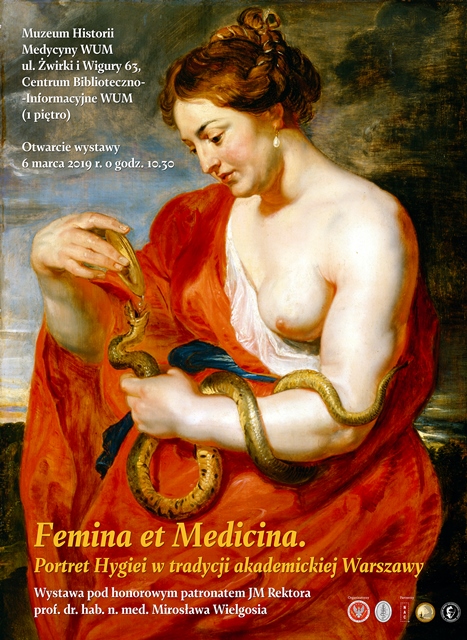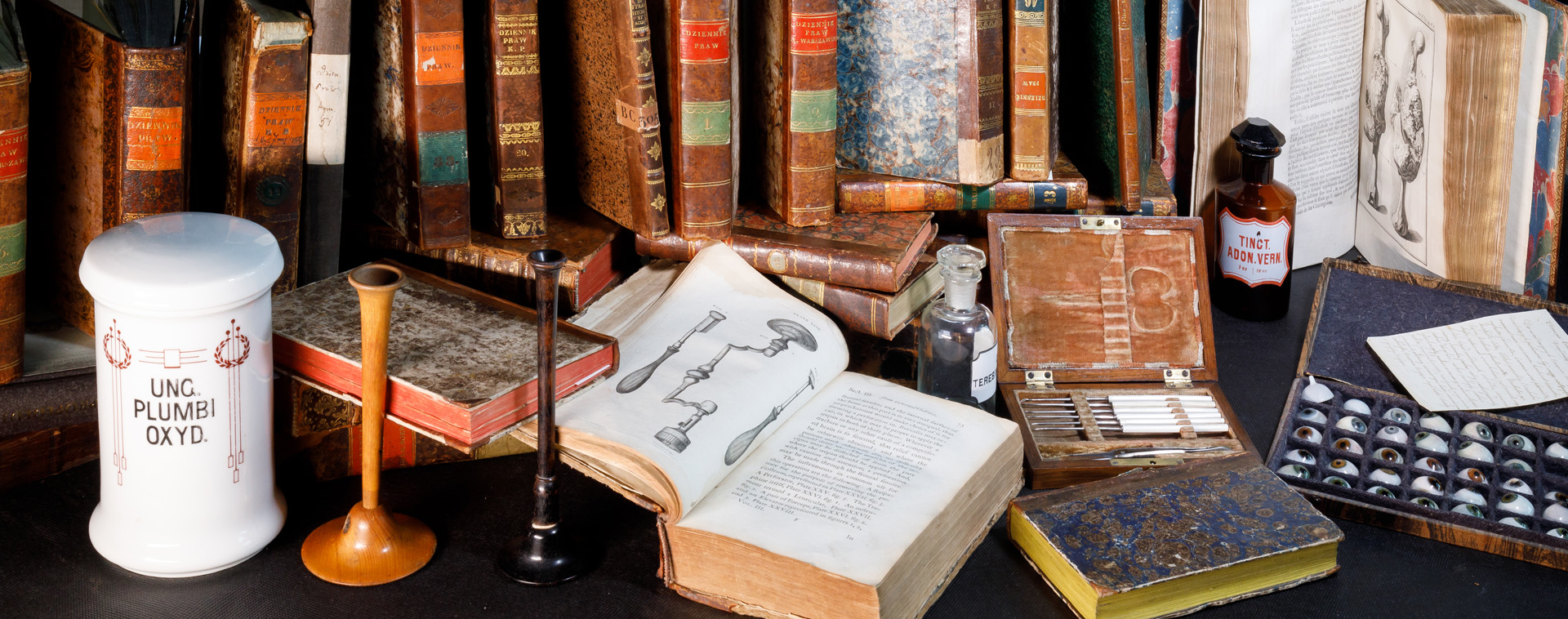
Rector of the Medical University of Warsaw prof. Mirosław Wielgoś, MD and Director of the Museum of the History of Medicine of the Medical University of Warsaw Adam Tyszkiewicz, PhD invite you to the opening of the exhibition entitled: Femina et Medicina. Portrait of Hygieia in the academic tradition of Warsaw.
Its opening will take place on March 6, 2019 at 10.30 am on the first floor in the building of the Library and Information Center, 63 Żwirki i Wigury St. Free Admission.
In the second decade of the seventeenth century, the famous Flemish artist, Peter Paul Rubens, painted one of the most striking images of Hygieia ever produced in early modern art. His goddess of health is not only an excellent personification of female beauty and sensuality—which is clearly accentuated by her exposed left breast and the redtones of her overgarment—but also of vigour, strength and health which are portrayed in her unusually muscular arms, reminiscent of the figures of the famous Sybils painted by Michelangelo in the Sistine Chapel. In Rubens’ lifetime, midwifery was the principle field of medicine that remained the domain of women. Louise Boursier, who was midwife to Queen Marie de Medici, wife of King Henry IV of France, was considered the most famous one at that time. It was much more difficult for women to become university students; at that time, only Italian universities admitted them for medical studies. The first women lecturers were also to be found in medical faculties in Italy. In the eleventh century the legendary female gynaecologist Trotula de Ruggiero, also known as Trota of Salerno, continued the tradition of Hygieia’s legacy, and in later centuries, the anatomist Anna Manzolini and pathologist Giuseppina Cattani, and others, were recorded in the annals of European academic medicine. Despite the many projects which attempted to introduce equality of women in academic life in the age of the Enlightenment, the situation did not change. The breakthrough did not come until the second half of the nineteenth century. Economic and social changes, as well as the development of feminist movements, greatly contributed to this. The University of Zurich was the first to admit women to study medicine on a regular basis. Soon afterwards, similar regulations were introduced in French higher education. Across the Atlantic Ocean women also grappled with the male-dominated academic system. However, they met with success in 1849 when Elizabeth Blackwell—known for fighting for women’s rights—became the first woman to receive a medical degree in the USA.The Jagiellonian University in Kraków was the first Polish university to award academic degrees to women. In 1824, two nuns from the Sisters of Charity of St. Vincent was not until the spring of 1894 that the first three women were officially admitted to study: Stanisława Dowgiałło, Janina Kosmowska and Jadwiga Sikorska. In Warsaw, the tradition of women participating in academic life dates back to the time of the Royal University of Warsaw (1816–1831). However, there were restrictions and women were only permitted to attend courses at the School of Midwifery which functioned alongside the Faculty of Medicine. In the following decades, given the disruption to academic teaching in Warsaw, the gates of the capital city’s university were closed to women. Perceivable changes were not made until the early 1920s. Graduates of Warsaw’s Higher Studies for Women were then admitted to classes at the Imperial University of Warsaw. However, women only became full members of the academic community when a Polish-language university was opened in 1915. The beginning was difficult, but the university taboo had been broken once and for all. The Faculty of Medicine was one of the most feminized faculties from the outset. Depending on the year, around 20–30% of the entrants were women. Even more women students could be seen at the Faculty of Pharmacy which opened in 1926. Nevertheless, very few representatives of the female gender actually had academic titles conferred upon them, and even fewer held positions as heads of hospital wards, departments and faculties. There were a few exceptions to the rule: Marta Erlich, professor of paediatrics, and the renowned rheumatologist, Eleonora Reicher. This state of affairs was of no surprise to anyone, since even ten years after the revival of the University, during the inauguration of the academic year, the rector of the University and outstanding dermatologist, Franciszek Krzyształowicz said:‘I would like to take time to consider that there are more and more women studying at the university, and you can look at this from many angles. In any case, I think this is a rather unhealthy affair because the women aspire to undertake a task which for them is usually unproductive, but which requires the management of a heavy workload, and a huge effort to be expended, both intellectually and economically’. However, this trend was unstoppable. Despite many similar reservations and doubts expressed with regard to the efforts of women to obtain a higher education, it was widely believed that in the field of academic medicine at the medical academy in Warsaw ‘Hygieia would soon prove herself a match for her father, Asclepius’. War when many women took part in underground teaching and functioned as nurses during the Warsaw Uprising. When the University of Warsaw was once again revived in 1945, life for women was a lot easier. They filled many a clinical hospital, as well as faculties and departments at the Faculty of Medicine and Pharmacy at the University of Warsaw, with their fine qualities, competence and knowledge, and from 1950 the Academy of Medicine also. Their academic achievements also began to gain appreciation; testimony of this was the awarding of honorary degrees, the highest accolade in the academic world, to Ewa Radwańska, Professor of Gynaecology (in 2002) and to Ewa Kuligowska, Professor of Radiology (in 2018).Currently there are more than 7,000 women at the Warsaw University of Medicine, which is around 74% of all students (as at December 2018). Many of women, as can be seen in the photograph on the pages umber 38-39, also hold some of the most important posts in the university’s administration. To paraphrase a certain saying, there is no doubt that ‘a university without women is like a garden without flowers’.
